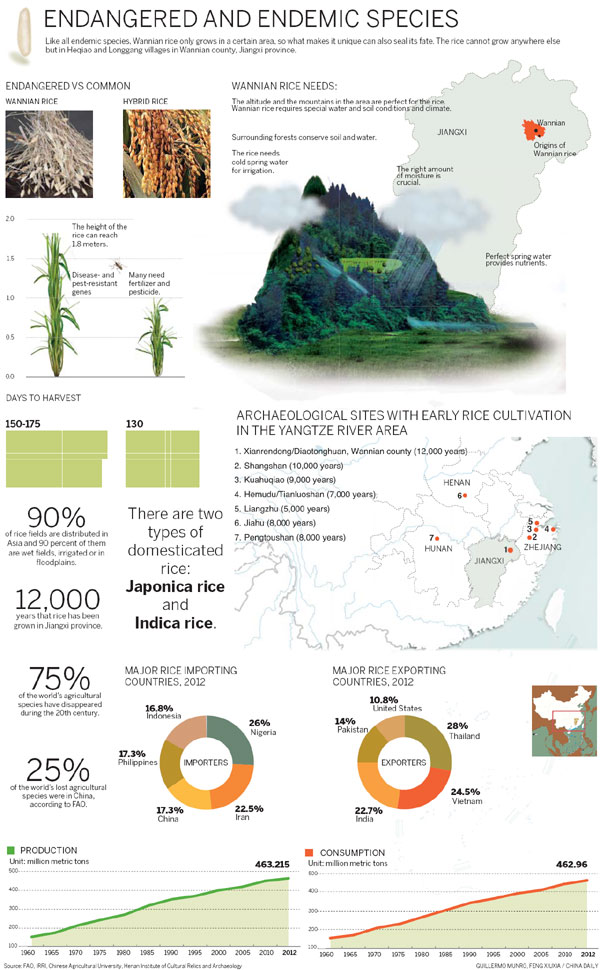Rice of ages
Updated: 2013-01-30 10:11
By Jin Zhu (China Daily)
|
|||||||||||

An heirloom species of this staple grain thrives only in a tiny pocket of East China, but scientists say its potential could be huge, Jin Zhu reports in Wannian, Jiangxi province.
Twenty hectares of arable land, tucked away in a mountain valley in Jiangxi province, may have a role to play in solving the worldwide food shortage.
A kind of rice that locals call Wuyuanzao has been grown in Wannian county in northeastern Jiangxi for more than 12,000 years.
The age-old rice variety is precious in the eyes of agriculture professionals. But Wu-yuanzao, commonly known today as Wannian rice, can only thrive in the county's Heqiao and Longgang villages, which are near Poyang Lake.
Experts believe this is because of the combination of cold spring water, special soil conditions and microclimate that are particular to the two villages.
The surrounding forests also play a crucial role in soil and water conservation, experts say, while the precious farmland planted with ancient rice is crowned by mist thanks to the moisture in the air.
Wannian rice has some advantages over other rice species.
It can reach 1.8 meters while ordinary rice grows less than 1 meter high.
Also, there is no need for pesticides or chemical fertilizers since this "heirloom" rice variety has proven resistant to insects and over centuries has adapted to low soil fertility.
Wannian rice also delivers richer nutrition than many other varieties, since it contains high levels of protein and vitamin B.
Its growing period is 160 to 175 days - much longer than the 130-day period for ordinary rice varieties. But scientists hope that cross-breeding the ancient rice with varieties that grow faster and adapt to more climates can produce a commercially viable hybrid rice that can feed many more people.
Zhan Ziyong, a local agriculture technician in Wan-nian county, notes that because of its sticky texture, the rice is particularly delicious when used to cook congee - the common porridge of South China.
According to historical records, in 1512 the county head brought some Wannian rice to the emperor of the Ming Dynasty (1368-1644). The emperor applauded the county's tribute to the royal family.
 |
In the 1990s, a team of Chinese and US archaeologists made headlines by proving that two sites in the county, Xianrendong and Diaotonghuan, were among the origins of the world's rice.
As the researchers dug at the site, they found phytoliths of cultivated rice. These mineral secretions by plants - particularly silica - help scientists reconstruct what plants were present at a site centuries after the organic matter has decayed and dissipated.
The findings pushed back the world's historical dating of rice domestication from 7,000 years ago to about 12,000 years ago.
"Wannian rice's original germplasm resource needs to be protected for rice breeding in the future," says Min Qing-wen, an agricultural researcher from the Institute of Geographic Sciences and Natural Resources Research under the Chinese Academy of Sciences.
The importance of China's research into germplasm resources for hybrid rice has been well-established by prominent Chinese scientist Yuan Longping in the country's central Hunan province.
The original seed resources for his productive hybrid rice came from a field of wild rice now preserved in Sanya, Hai-nan province.
Rice is the staple food for more than 50 percent of the world's population and about 60 percent of China's 1.3 billion people.
Related Stories
Rice wine made in Rongshui Miao Autonomous County, China's Guangxi 2012-12-17 11:55
Wannian Traditional Rice Culture, China 2012-12-17 11:54
Eat the right food for each meal on Xiaohan 2013-01-05 10:50
Taking a bite of halal food in China's Ningxia 2012-12-29 14:01
Today's Top News
Police continue manhunt for 2nd bombing suspect
H7N9 flu transmission studied
8% growth predicted for Q2
Nuke reactor gets foreign contract
First couple on Time's list of most influential
'Green' awareness levels drop in Beijing
Palace Museum spruces up
Trading channels 'need to broaden'
Hot Topics
Lunar probe , China growth forecasts, Emission rules get tougher, China seen through 'colored lens', International board,
Editor's Picks

|

|

|

|

|

|






